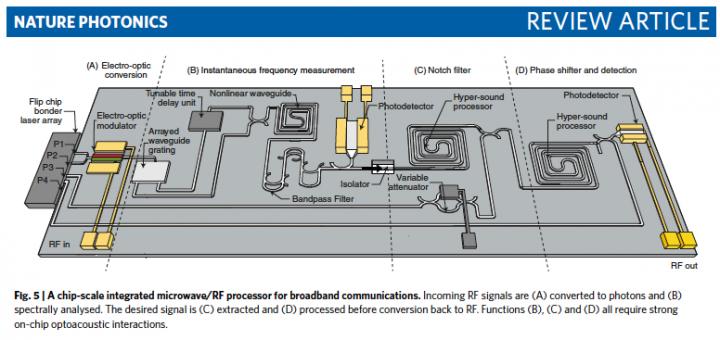Photonics HandbookResearch & Technology
Harnessing Light-Sound Interactions on a Single Chip
SYDNEY, Aug. 21, 2019 — A growing group of scientists is adapting Brillouin scattering to a new generation of integrated circuits for 5G and broadband networks, sensors, satellite communication, radar systems, and defense.
While the feedback that causes light to scatter inside optical fibers can reduce the strength of an optical signal, this feedback process can also be used to integrate optical information into a chip. Professor Ben Eggleton, director of the University of Sydney Nano Institute, is investigating how to apply photon-phonon interaction, and with others in the field, he has published a paper outlining the history and potential of what scientists refer to as “Brillouin integrated photonics.”

Conceptual illustration of integrated circuit incorporating stimulated Brillouin scattering devices. Courtesy of Nature Photonics.
In stimulated Brillouin scattering (SBS) light and sound waves are coupled, making it possible to create an enhanced feedback loop between photons and phonons. Increasing the power of the Brillouin feedback effect through SBS could offer a new way to integrate optical information into a chip environment using sound waves as a buffer to slow down the data without the heat that electronic systems produce.
“Managing information on a microchip can take up a lot of power and produce a lot of heat,” Eggleton said. “Further, integrated circuits using SBS offer the opportunity to replace components in flight and navigation systems that can be 100× or 1000× heavier. That will not be a trivial achievement.”

Professor Ben Eggleton at the Sydney Nanoscience Hub in the University of Sydney Nano Institute. Courtesy of the University of Sydney.
In 2017, Eggleton’s group demonstrated the transfer of light to acoustic information on a chip. The team further developed a chip-based information recovery technique that eliminated the need for bulky processing systems.
Additional advances are necessary before a chip-scale, light-sound integrated system can be deployed commercially, but the payoff in terms of size, weight, and power (SWAP) will be worth the effort, Eggleton said. The next challenge is to develop an architecture that integrates microwave and radio frequency processors with optical-acoustic interactions.
Another challenge will be to reduce noise in the system caused by unwanted light scattering deteriorating the signal-to-noise ratio. One possible approach is to have chips operating at cryogenic temperatures, the researchers said. While this would have significant practical implications, it could also provide greater control of the photon-phonon interaction.
The group is also investigating materials on which to build its integrated systems. Silicon has obvious appeal, given that most microelectronics are built using this cheap, abundant material. However, the silica used in optical fibers, when coupled with a silicon substrate, could allow information to leak out, given the similarity of materials.
The University of Sydney Nano Institute has recently signed a partnership with the Royal Australian Air Force (RAAF) to work with its program to advance RAAF’s sensing capability. Lockheed Martin and Harris Corp. are also working with the Eggleton group.
“The big advance here is in the simultaneous control of light and sound waves on really small scales,” said professor Christopher Poulton, one of the paper’s authors. “This type of control is incredibly difficult, not least because the two types of waves have extremely different speeds. The enormous advances in fabrication and theory outlined in this paper demonstrate that this problem can be solved and that powerful interactions between light and sound such as Brillouin scattering can now be harnessed on a single chip. This opens the door to a whole host of applications that connect optics and electronics.”
In addition to professors Eggleton and Poulton, the authors of the research are professor Peter Rakich at Yale University, professor Michael Steel at Macquarie University, and professor Gaurav Bahl at the University of Illinois at Urbana-Champaign.
The research was published in Nature Photonics (https://doi.org/10.1038/s41566-019-0498-z).
/Buyers_Guide/Lockheed_Martin_Coherent_Technologies/c8703